SOWK 487 Week 11 Group Work Approaches Related to Settings Part 1
A presentation at Heritage @ CBC Week 11 in in Pasco, WA 99301, USA by Jacob Campbell
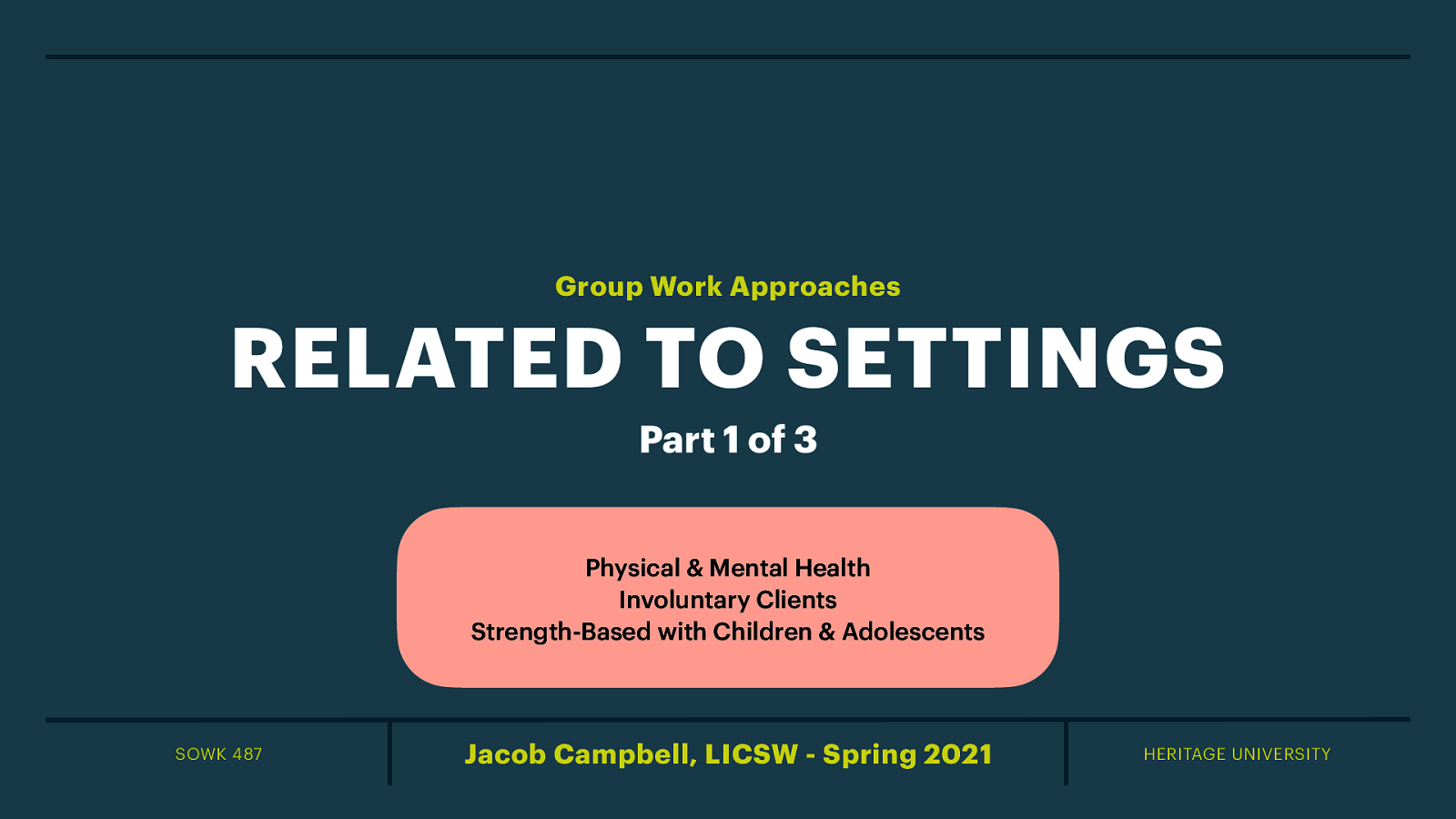
SOWK 487 Spring 2021 Planning: Class 11
Time: Wednesday’s from 5:30-8:15
Date: 03/24/21
Content: Group Work Approaches Related to Setting I
Reading Assignment: Garvin et al. (2017) Chapters 13-16
Due Dates:
- A-01: Synchronous Class Engagement Attend class
- A-02: Asynchronous Class EngagementW-11 Groups with Involuntary Clients discussion forum with an initial post due Friday 03/26/21 at 11:55 PM and two replies due Sunday 03/28/21 at 11:55 PM via My Heritage Class Forum
- Read Garvin et al. (2017) Chapters 13-16
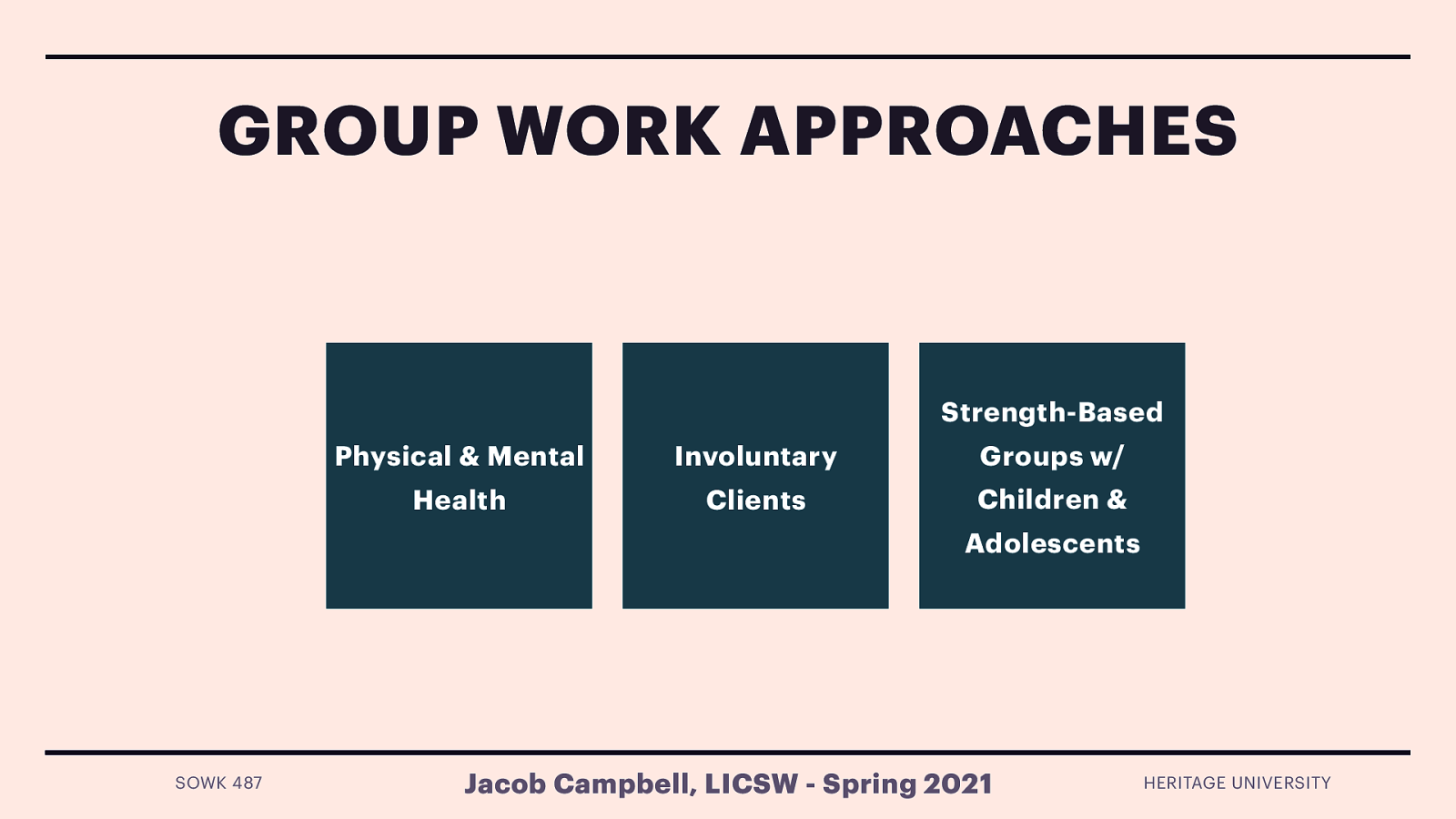
Group Work Approaches
The reading discussed three different settings that group work can be done in. These are:
- Groups in physical and mental health
- Involuntary groups
- Strengths-based group work with adolescents
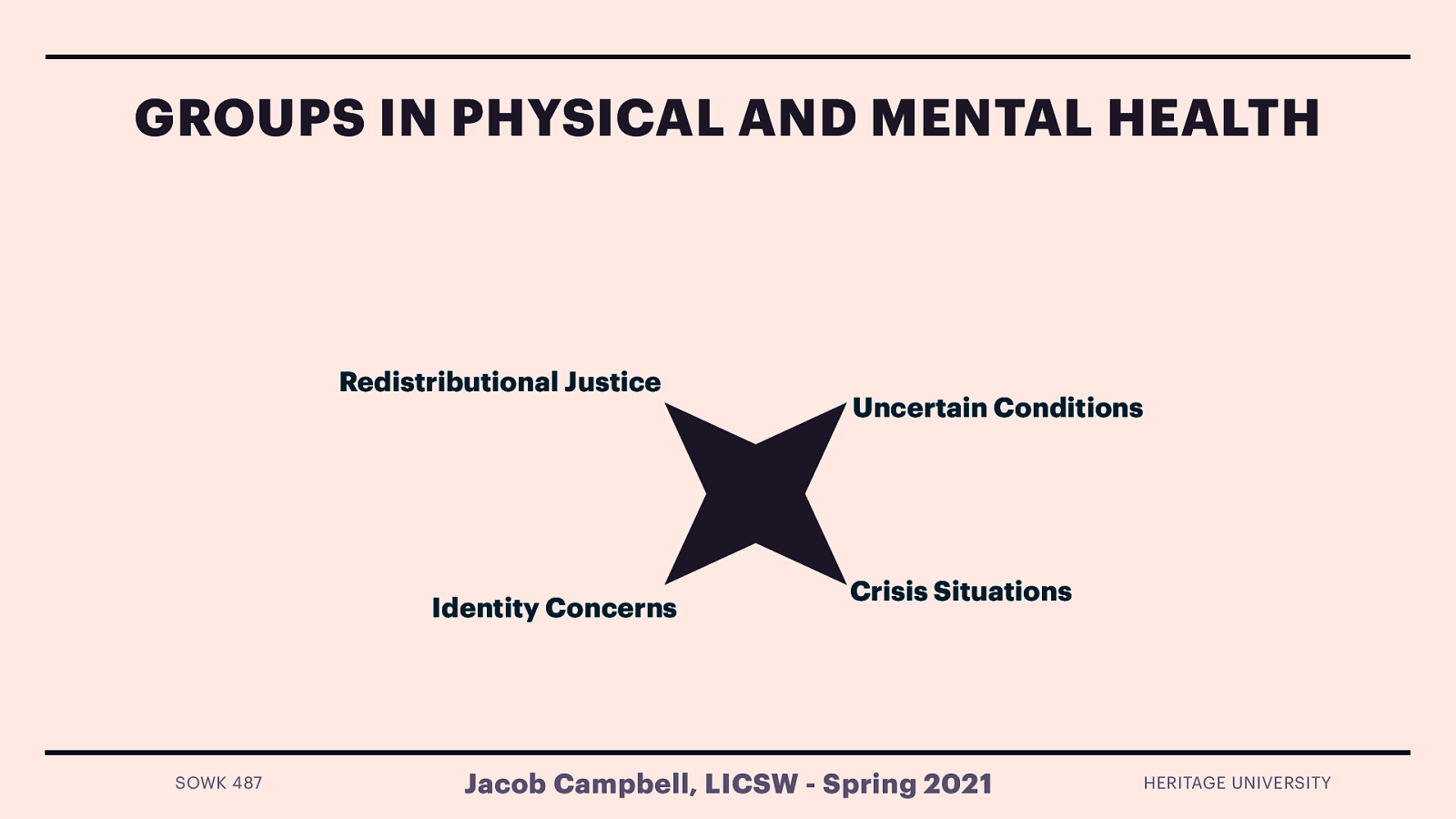
Groups in Physical and Mental Health
Getzel (2012) describes four variables that should be considered in who should be placed in groups in a health care setting and intervened in during the group cycle.
- Uncertain Conditions: Frequently at begging phase, but can occur whenever. Role to encourage explorations of group conflicts as problems for the members to solve together
- Crisis Situations: Crisis happens
- we can’t take an “overprotective stance.”
- Crisis can be internal and external
- Role is to assist group in managing and addressing the crisis situations
- Identity Concerns: Identity themes especially prevalent in groups with persons with serious illness or trauma.
- With strong cohesion— can more directly address identity questions
- Role to process through mutual aid
- Redistrubutional justice: Think empowerment theory. Addressing social just needs as a group outside of the group
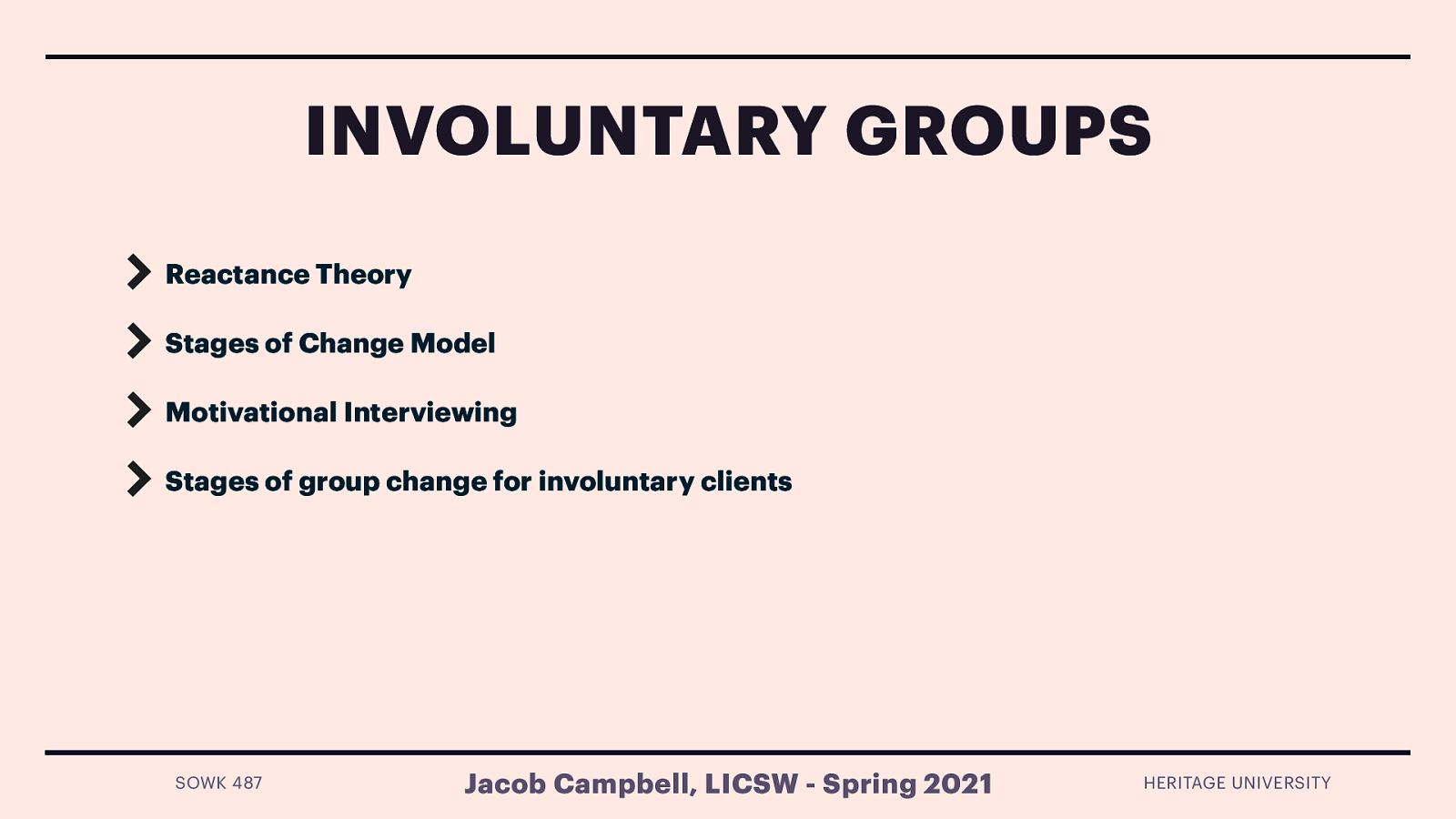
Involuntary Groups
Many groups that are led are working with clients who are in some way being forced to attend (courts, parents, probation, school, etc.)
Some interventions that are frequently employed are:
- Reactance Theory: People are free to do any behavior.
- When people feel not free, they have more resistance. When people feel free more willing to participate. Role to offer choices, clarifying mandated portions… etc.
—> Doing these in a minute
- Stages of Change Model:
- Motivational Interviewing:
- Stages of group change for involuntary clients: suggestions of what to do regarding the beginning, middle, and end.
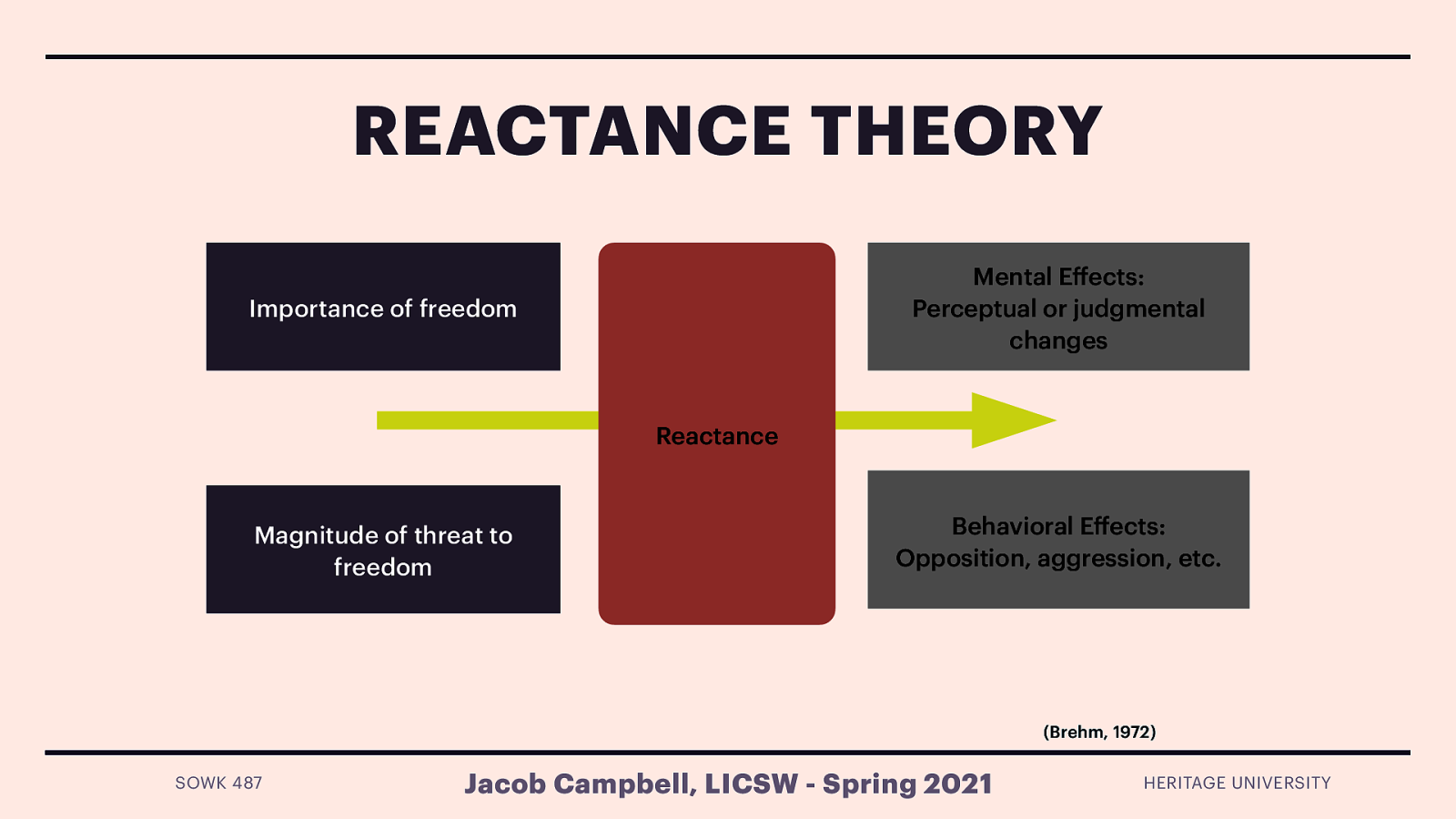
Reactance Theory
Brehm (1972) talked about Reactance (well and had been writing about it since the sixties).
- Importance of the freedom
- Magnitude of threat to freedom
Creates Reactance
- Mental Effects: Perceptual or judgmental changes
- Behavioral Effects: Opposition, aggression, etc.
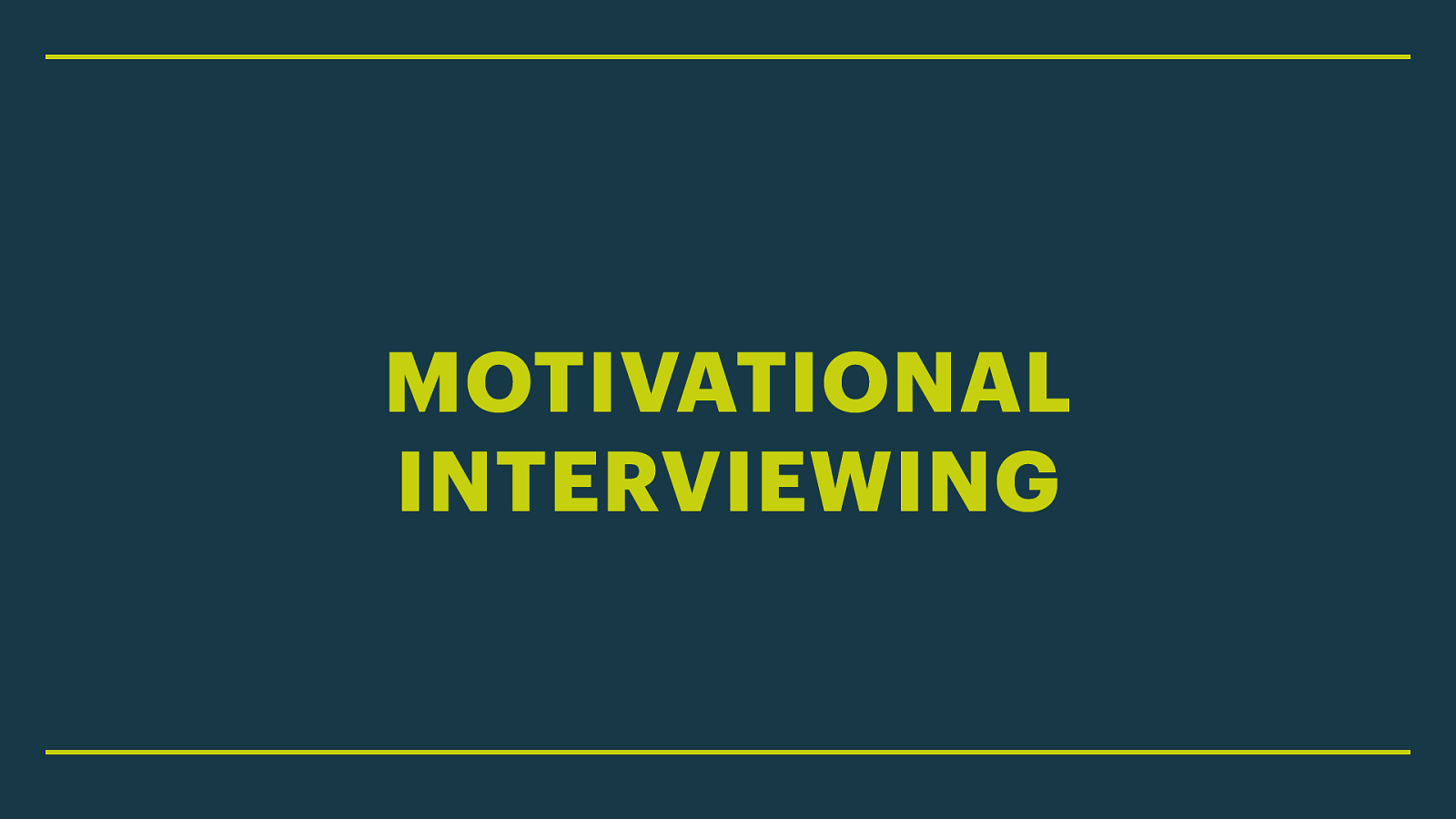
Motivational Interviewing
Because motivational interviewing is so key in working with involuntary groups, I want to talk about the stages of change with you.
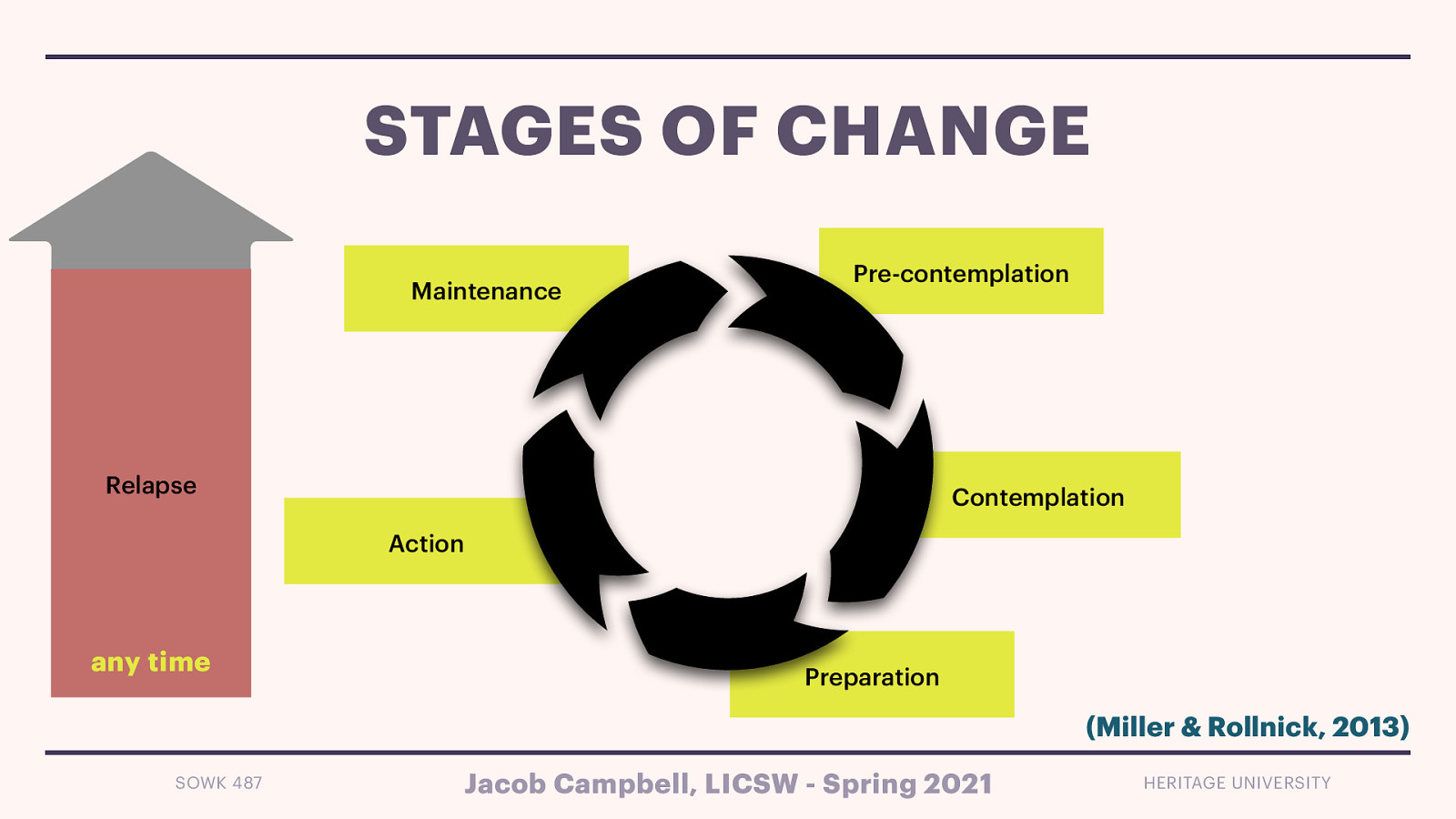
Stages of Change
Motivational Interviewing looks at change in stages.
- Pre-contemplation
- Contemplation
- Preparation
- Action
- Maintenance
- Relapse
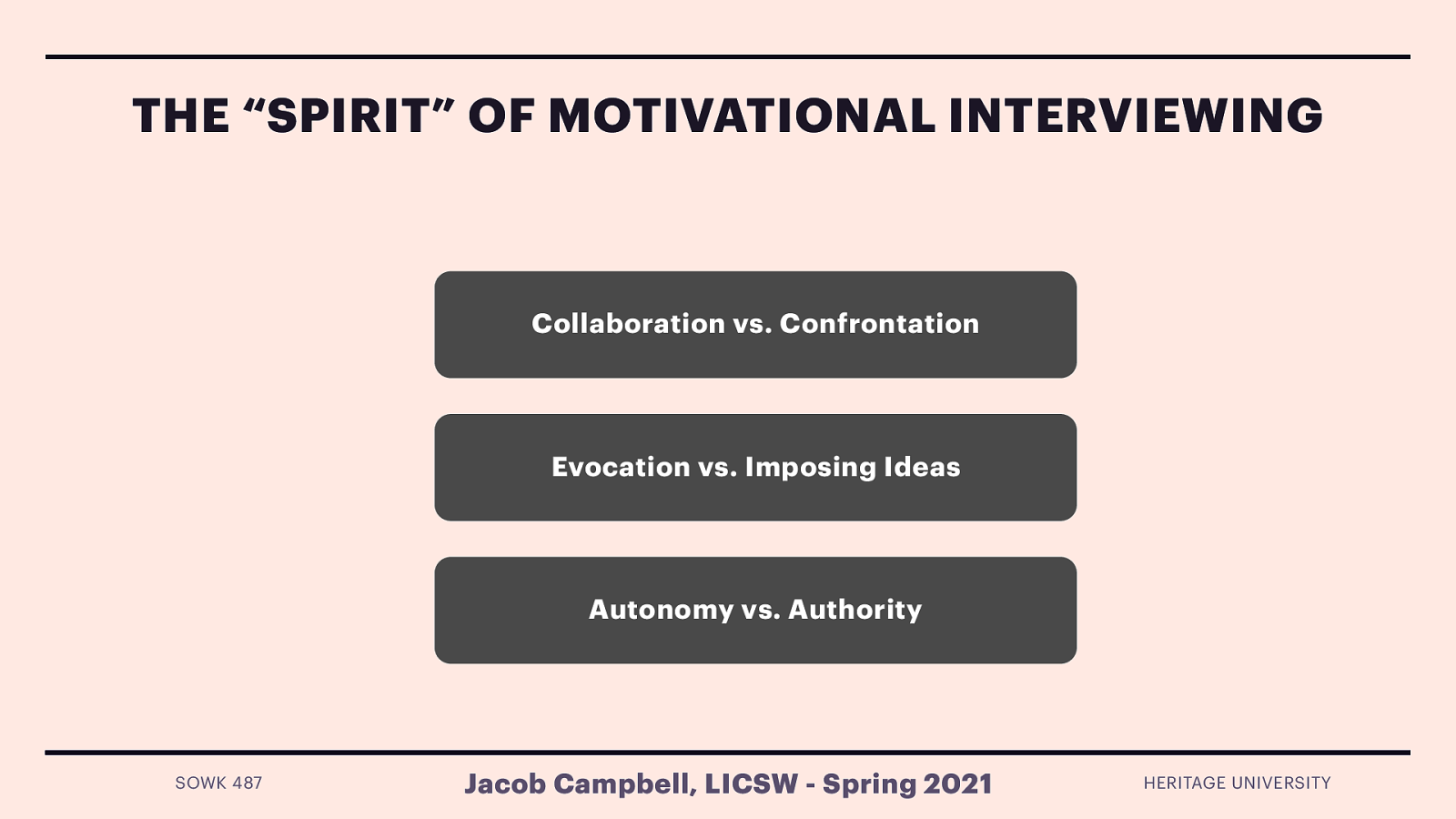
The "Spirit" of Motivational Interviewing
MI is more than the use of a set of technical interventions. It is characterized by a particular “spirit” or clinical “way of being” which is the context or interpersonal relationship within which the techniques are employed.
The spirit of MI is based on three key elements:
- Collaboration between the therapist and the client
- Evoking or drawing out the client’s ideas about change
- Emphasizing the autonomy of the client.
- Collaboration (vs. Confrontation)
- Collaboration is a partnership between the therapist and the client, grounded in the point of view and experiences of the client.
- This contrasts with some other approaches to substance use disorders treatment, which are based on the therapist assuming an “expert” role, at times confronting the client and imposing their perspective on the client’s substance use behavior and the appropriate course of treatment and outcome.
- Collaboration builds rapport and facilitates trust in the helping relationship, which can be challenging in a more hierarchical relationship.
- This does not mean that the therapist automatically agrees with the client about the nature of the problem or the changes that may be most appropriate.
- Although they may see things differently, the therapeutic process is focused on mutual understanding, not the therapist being right.
- Evocation (Drawing Out, Rather Than Imposing Ideas)
- The MI approach is one of the therapist’s drawing out the individual’s own thoughts and ideas, rather than imposing their opinions as motivation and commitment to change is most powerful and durable when it comes from the client.
- No matter what reasons the therapist might offer to convince the client of the need to change their behavior or how much they might want the person to do so, lasting change is more likely to occur when the client discovers their own reasons and determination to change.
- The therapist’s job is to “draw out” the person’s own motivations and skills for change, not to tell them what to do or why they should do it.
- Autonomy (vs. Authority)
- Unlike some other treatment models that emphasize the clinician as an authority figure, Motivational Interviewing recognizes that the true power for change rests within the client.
- Ultimately, it is up to the individual to follow through with making changes happen.
- This is empowering to the individual, but also gives them responsibility for their actions.
- Counselors reinforce that there is no single “right way” to change and that there are multiple ways that change can occur.
- In addition to deciding whether they will make a change, clients are encouraged to take the lead in developing a “menu of options” as to how to achieve the desired change.
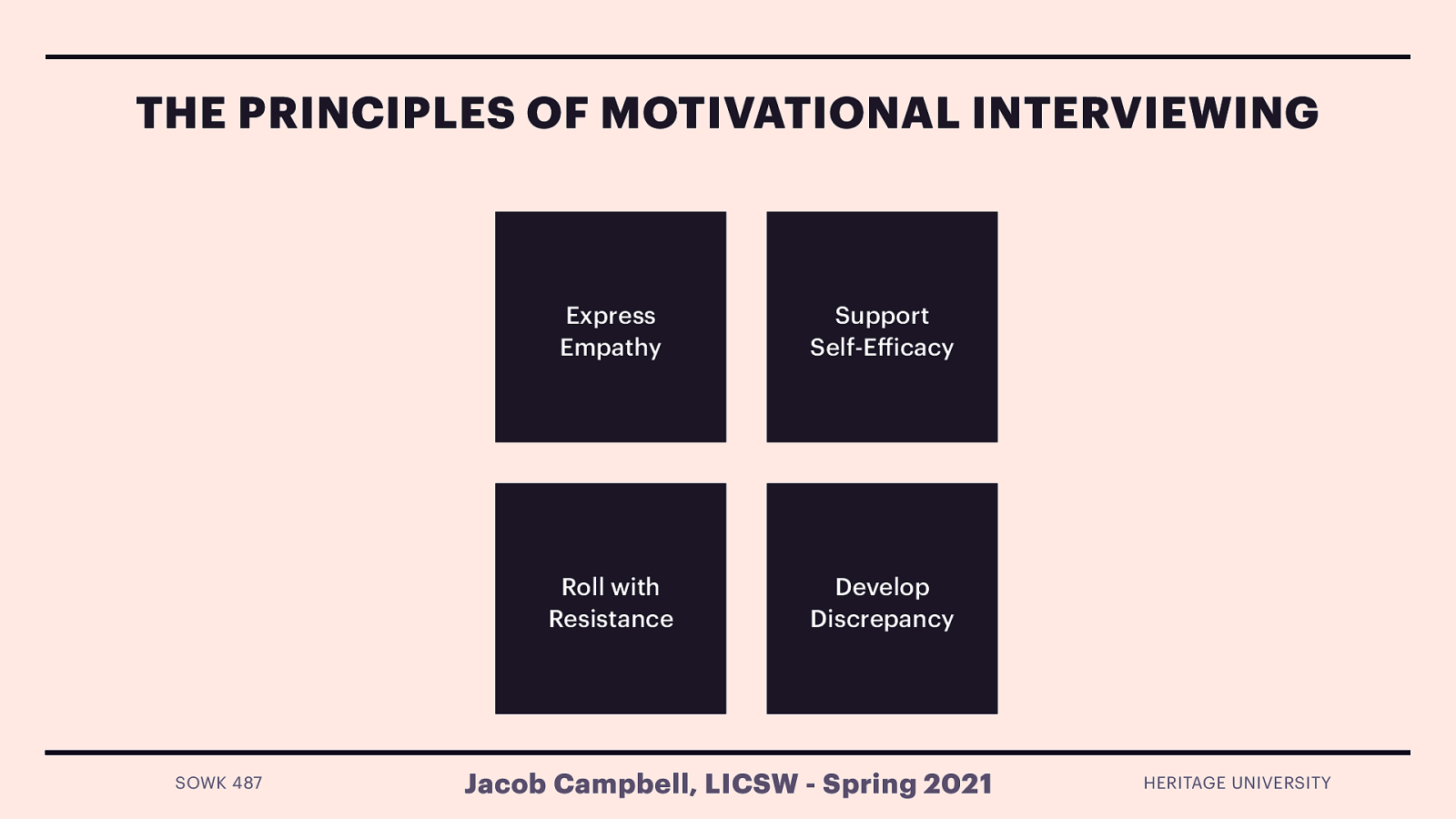
The Principles of Motivational Interviewing (1 of 5)
The book discusses how to deal with discrepancy. Developing discrepancy is one of the four guiding principles in Motivational Interviewing. Building on and bringing to life the elements of the MI “style,” there are four distinct principles that guide the practice of MI. The therapist employing MI will hold true to these principles throughout treatment.
- Express Empathy (i.e. seeing, thinking, feeling, and sharing through the clients eyes)
- Support Self-Efficacy (i.e. A strengths based approach)
- Roll with Resistance (i.e. Dancing with the client vs. wrestling)
- Develop Discrepancy (i.e. Where I am vs. where I want to be)
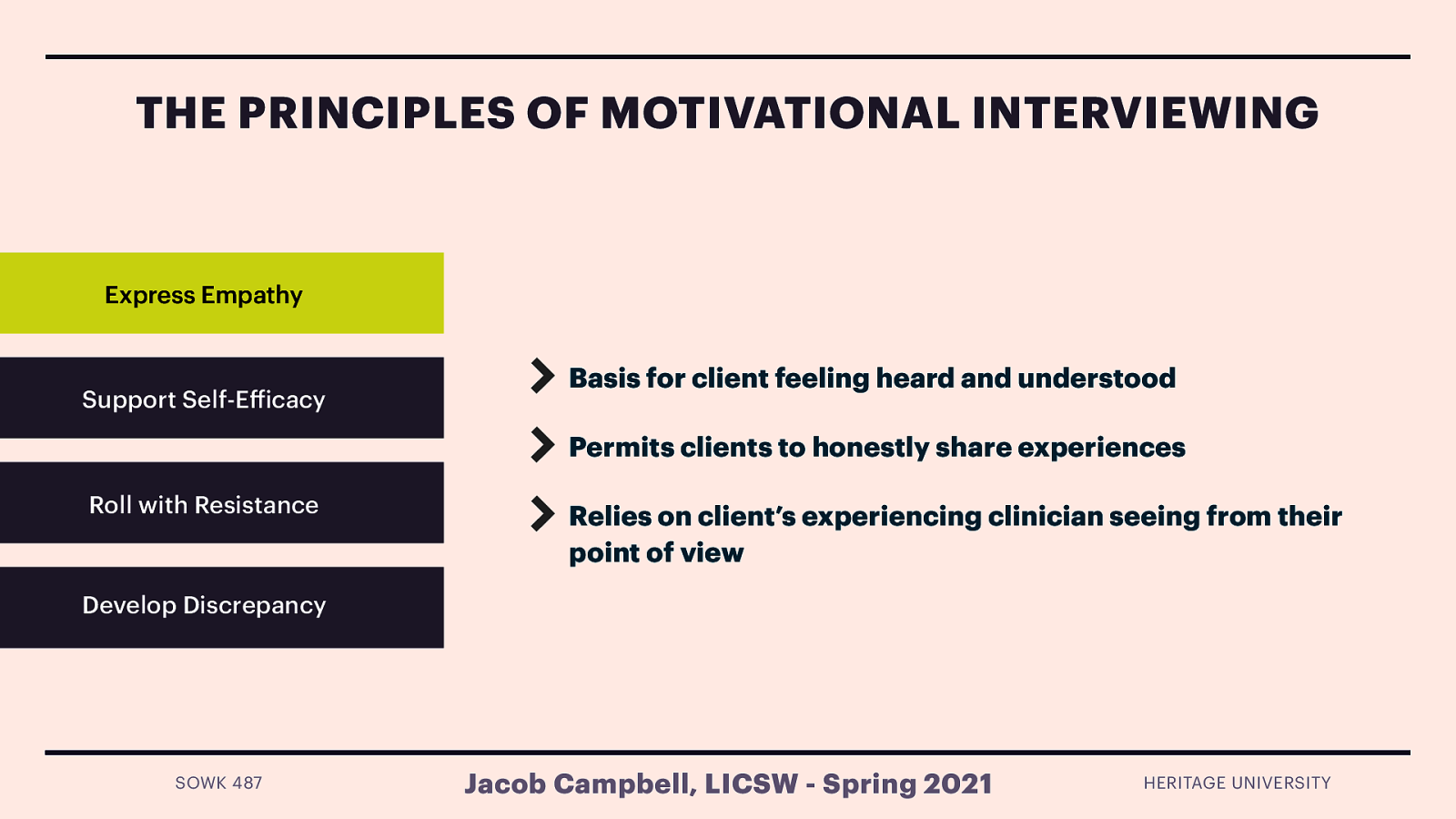
The Principles of Motivational Interviewing (2 of 5)
Expressing empathy involves seeing the world through the client’s eyes, thinking about things as the client thinks about them, feeling things as the client feels them, and sharing in the client’s experiences
- This approach provides the basis for clients to be heard and understood
- Permits clients to be more likely to honestly share their experiences in depth.
- The process of expressing empathy relies on the client’s experiencing the counselor as able to see the world as they (the client) sees it.
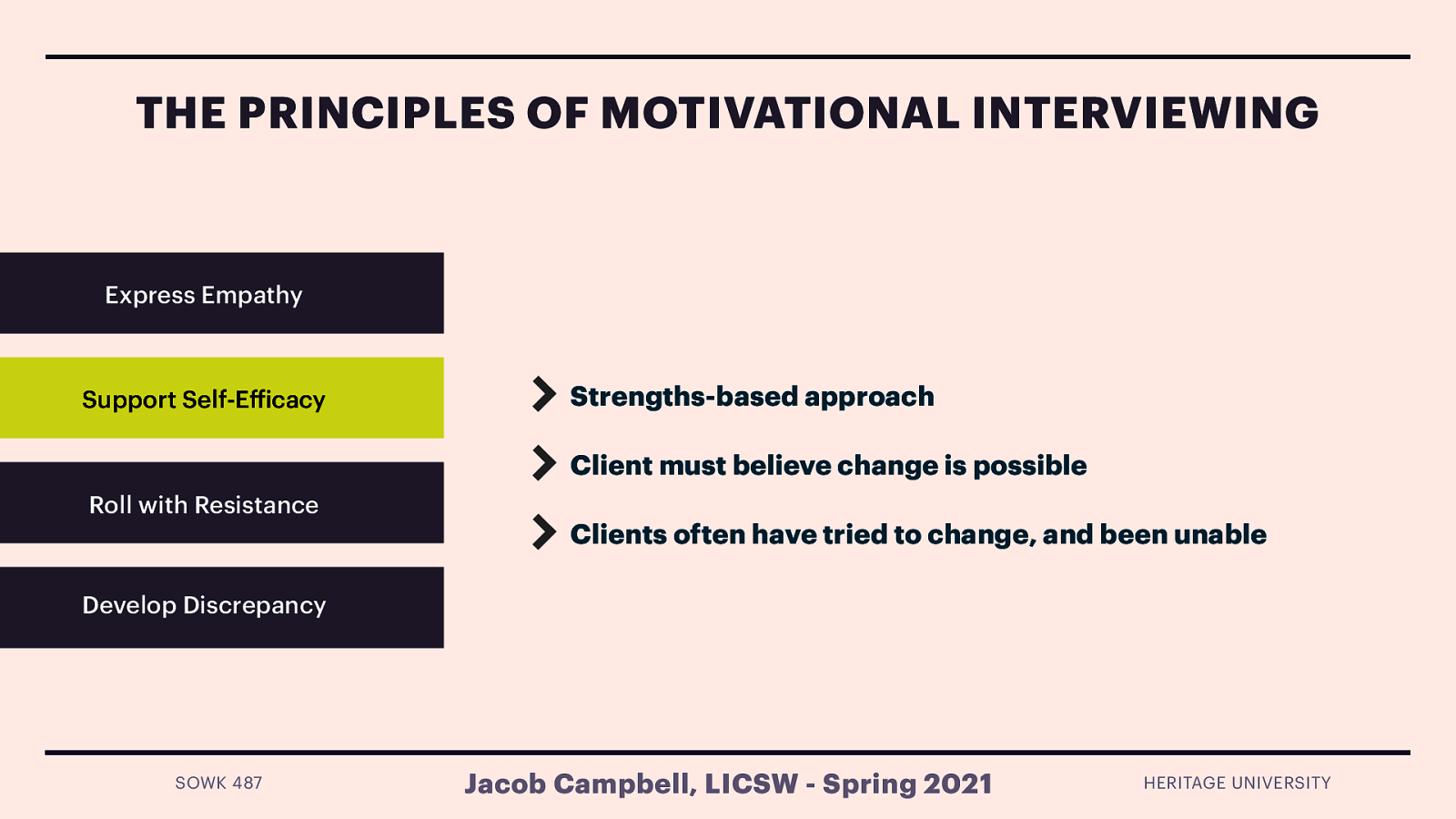
The Principles of Motivational Interviewing (3 of 5)
Supporting self-efficacy in motivational interviewing is the counselor focusing on previous successes and highlighting skills and strengths.
- MI is a strengths-based approach that believes that clients have within themselves the capabilities to change successfully.
- A client’s belief that change is possible (self-efficacy) is needed to instill hope about making those difficult changes.
- Clients often have previously tried and been unable to achieve or maintain the desired change, creating doubt about their ability to succeed.
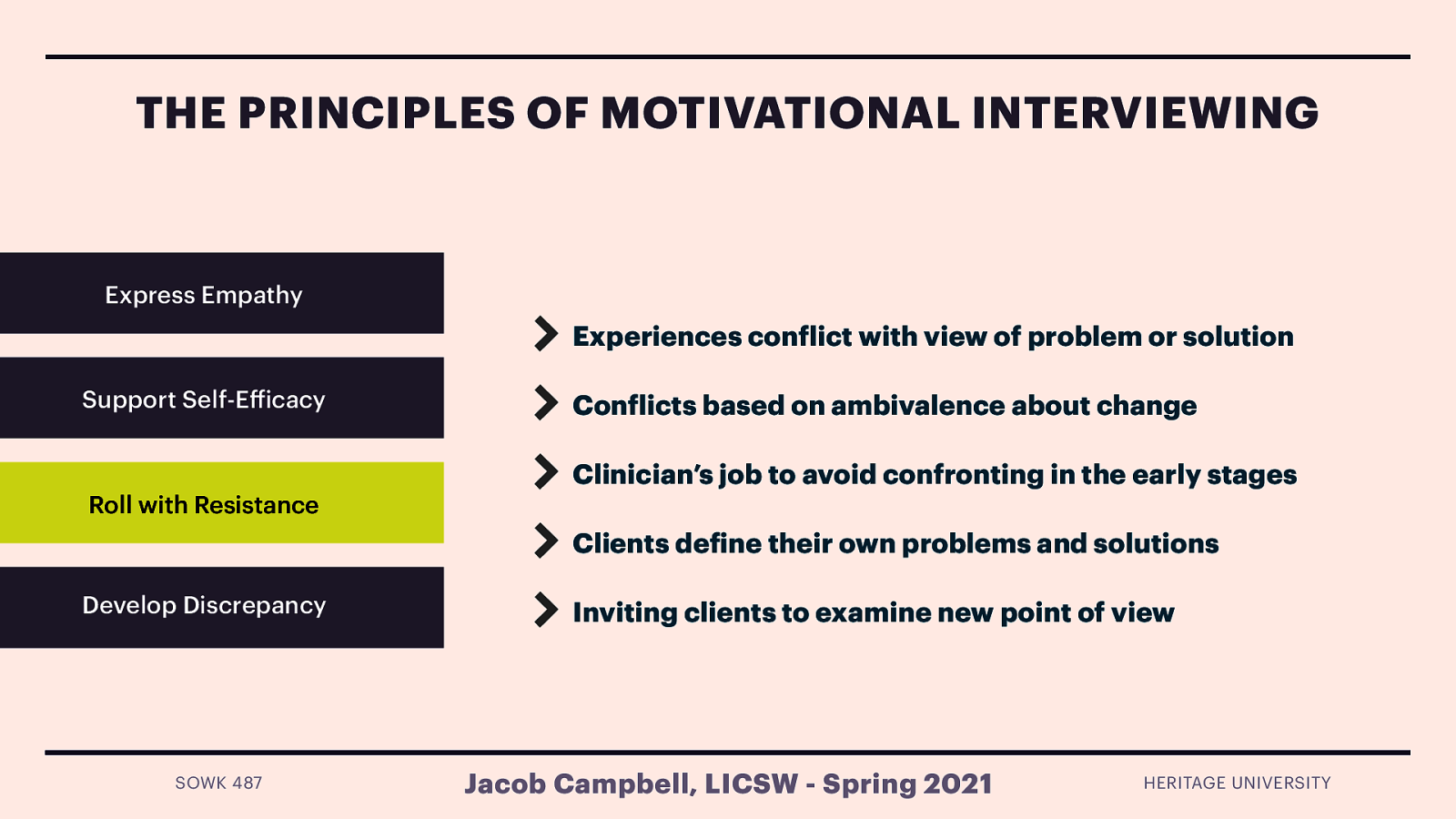
The Principles of Motivational Interviewing (4 of 5)
Rolling with resistance disrupts any “struggle” that may occur and the session does not resemble an argument or the client’s playing “devil’s advocate” or “yes, but” to the counselor’s suggestions.
- From an MI perspective, resistance in treatment occurs when then the client experiences a conflict between their view of the “problem” or the “solution” and that of the clinician or when the client experiences their freedom or autonomy being impinged upon.
- These experiences are often based in the client’s ambivalence about change.
- In MI, counselors avoid eliciting resistance by not confronting the client and when resistance occurs, they work to de-escalate and avoid a negative interaction, instead “rolling with it.” Actions and statements that demonstrate resistance remain unchallenged especially early in the counseling relationship.
- The MI value on having the client define the problem and develop their own solutions leaves little for the client to resist.
- A frequently used metaphor is “dancing” rather than “wrestling” with the client.
- In exploring client concerns, counselors invite clients to examine new points of view, and are careful not to impose their own ways of thinking.
- A key concept is that counselor’s avoid the “righting reflex,” a tendency born from concern, to ensure that the client understands and agrees with the need to change and to solve the problem for the client.
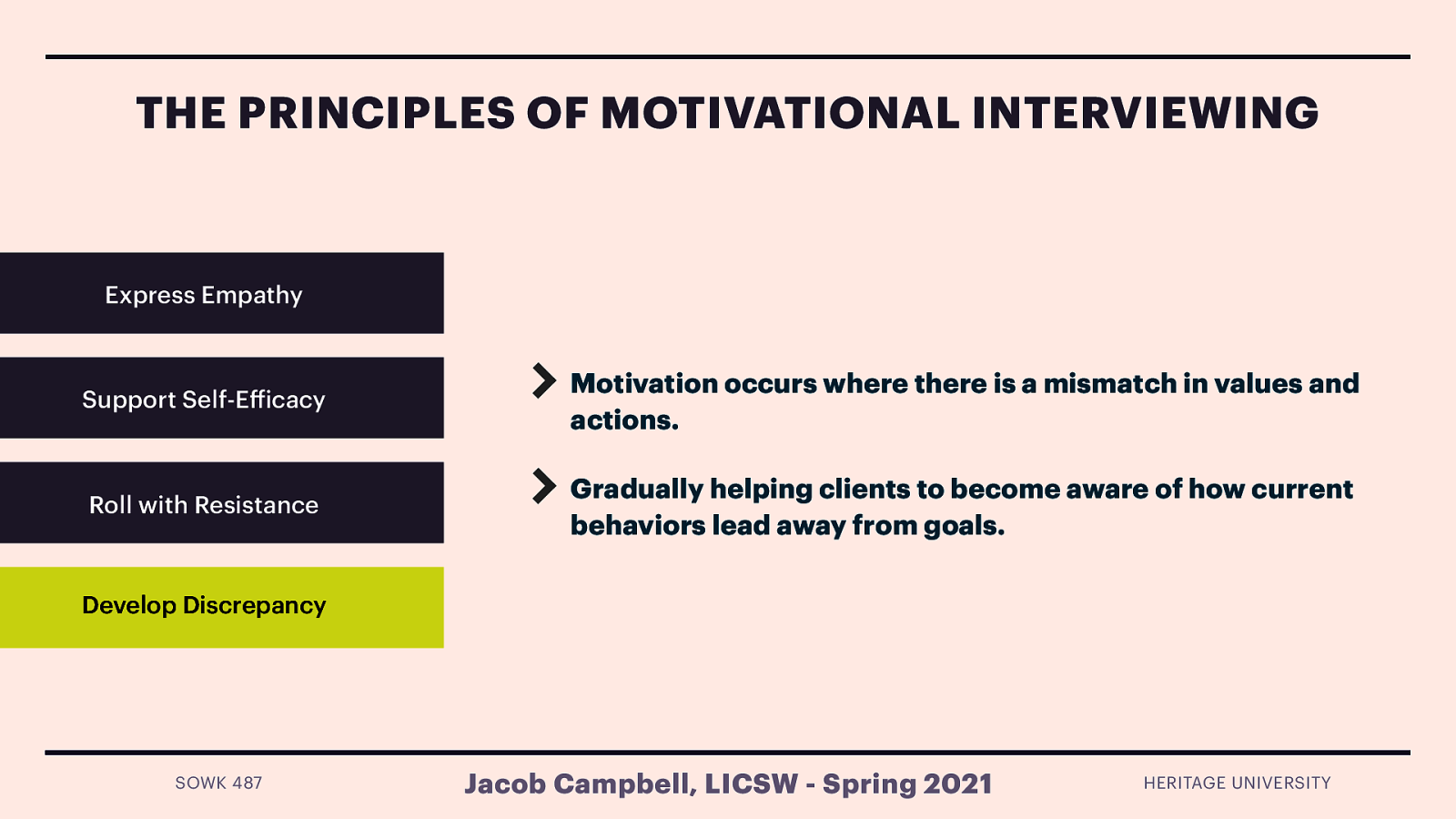
The Principles of Motivational Interviewing (5 of 5)
Developing discrepancy guiding client to understand the mismatch between where the client wants to be and where they are.
- Motivation for change occurs when people perceive a mismatch between “where they are and where they want to be,” and a counselor practicing Motivational Interviewing works to develop this by helping clients examine the discrepancies between their current circumstances/behavior and their values and future goals.
- When clients recognize that their current behaviors place them in conflict with their values or interfere with accomplishment of self-identified goals, they are more likely to experience increased motivation to make important life changes.
- It is important that the counselor using MI does not use strategies to develop discrepancy at the expense of the other principles, yet gradually help clients to become aware of how current behaviors may lead them away from, rather than toward, their important goals. [Whole Class Activity] Have students work with partners regarding something that there has been some resistance to change. Work through some of the principles with your partner.
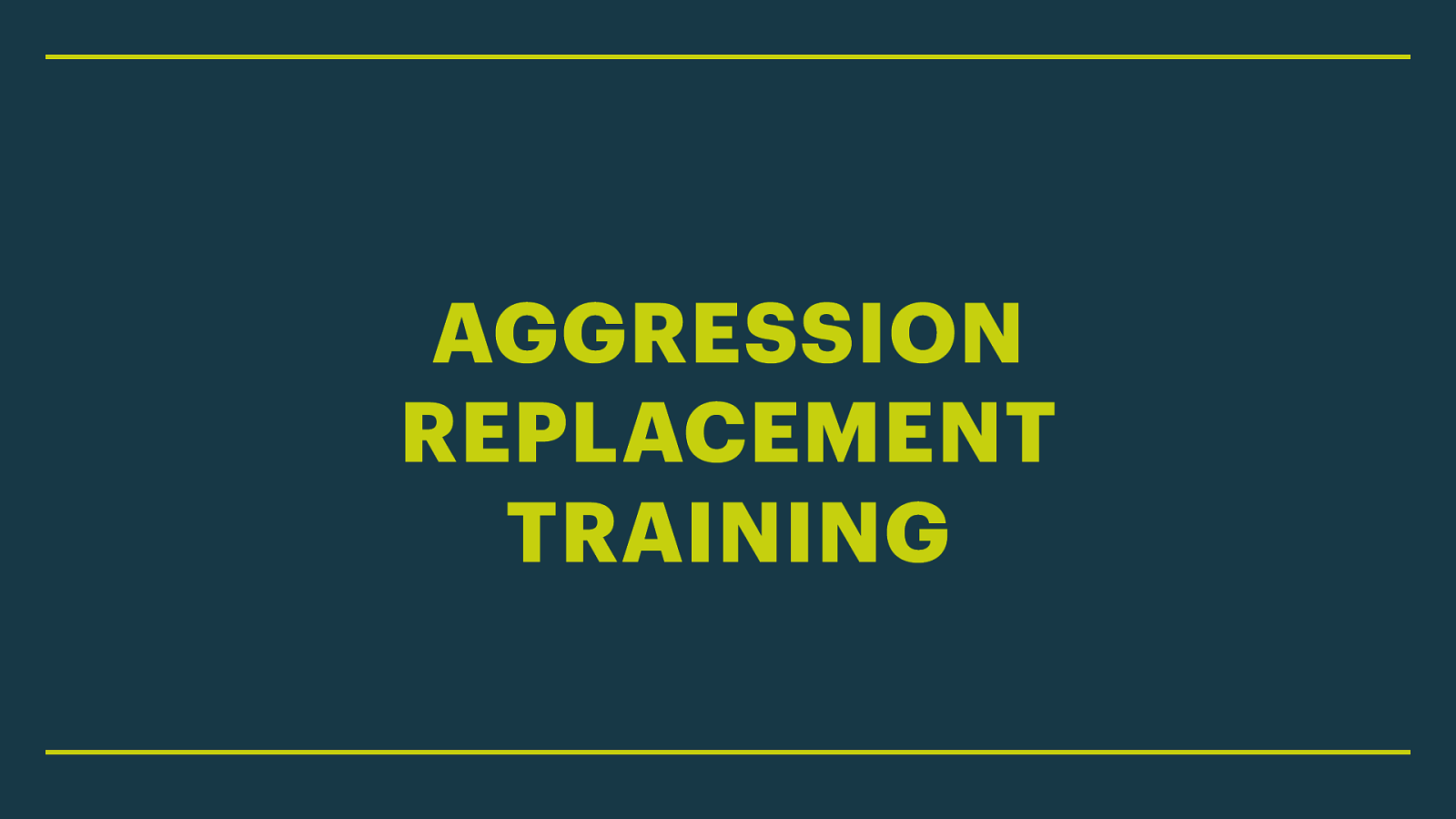
Aggression Replacement Training
While ART’s moral reasoning day is different than a truly sophistry method discussed as a method for examining faculty beliefs, it fits in very well with working with involuntary clients.
[Whole Class Activity] 10 volunteers (participants) 1 volunteer co-facilitator others observers. Facilitate moral reasoning day as listed below. Students do not need to necessarily take on a part, but answer honestly or they can act as a persona.
- Review Rules for Discussion (See page 111 of Aggression Replacement Training, Revised Edition)
- Introduce/Review Thinking Errors. (See pgs. 98 & 99)
- Have a group member read the Problem Situation aloud.
- Establish the “real” problem so that all group members clearly understand the problem.
- Relate the Problem Situation to the lives of the group members.
- Establish Moral Maturity through eliciting mature responses first, reconstructing less mature responses, and listing them on an ease pad, chalk board, or white board preferably on one side of a T-chart.
- List less morally mature responses second on the other side of the T-chart if they cannot be reconstructed to seem more mature. Provide no reinforcement for less mature reasoning.
- Encourage more mature group members and use the list of mature reasons on the chart to challenge the less mature reasoning of group members.
- Provide perspective taking opportunities by having youth who disagree examine each other’s reasoning for thinking errors.
- Provide role taking opportunities for group participants. (e.g. How would you feel if you were . . ? What would you do if you were …?)
- When possible seek to make more mature answers and reasons for those answers a group decision.
- Praise the group and individuals within the group for positive decisions and mature reasoning.
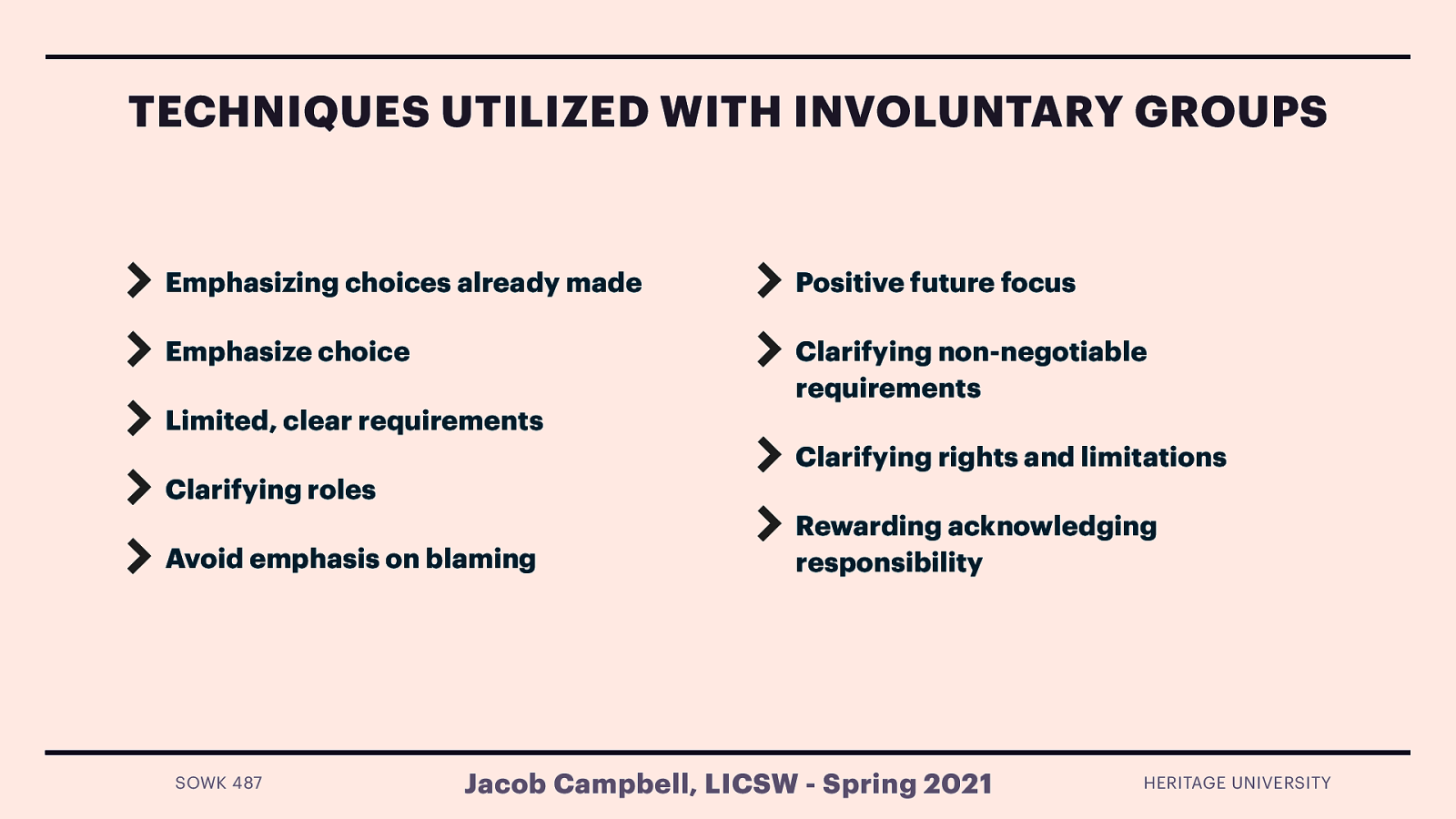
Techniques Utilized with Involuntary Groups
The following are some techniques that are frequently used with involuntary clients.
- Emphasizing choices already made (baby steps)
- Emphasize choice
- Limited, clear requirements
- Clarifying roles
- Avoid emphasis on blaming
- Positive future focus
- Clarifying non-negotiable requirements
- Clarifying rights and limitations
- Rewarding acknowledging responsibility
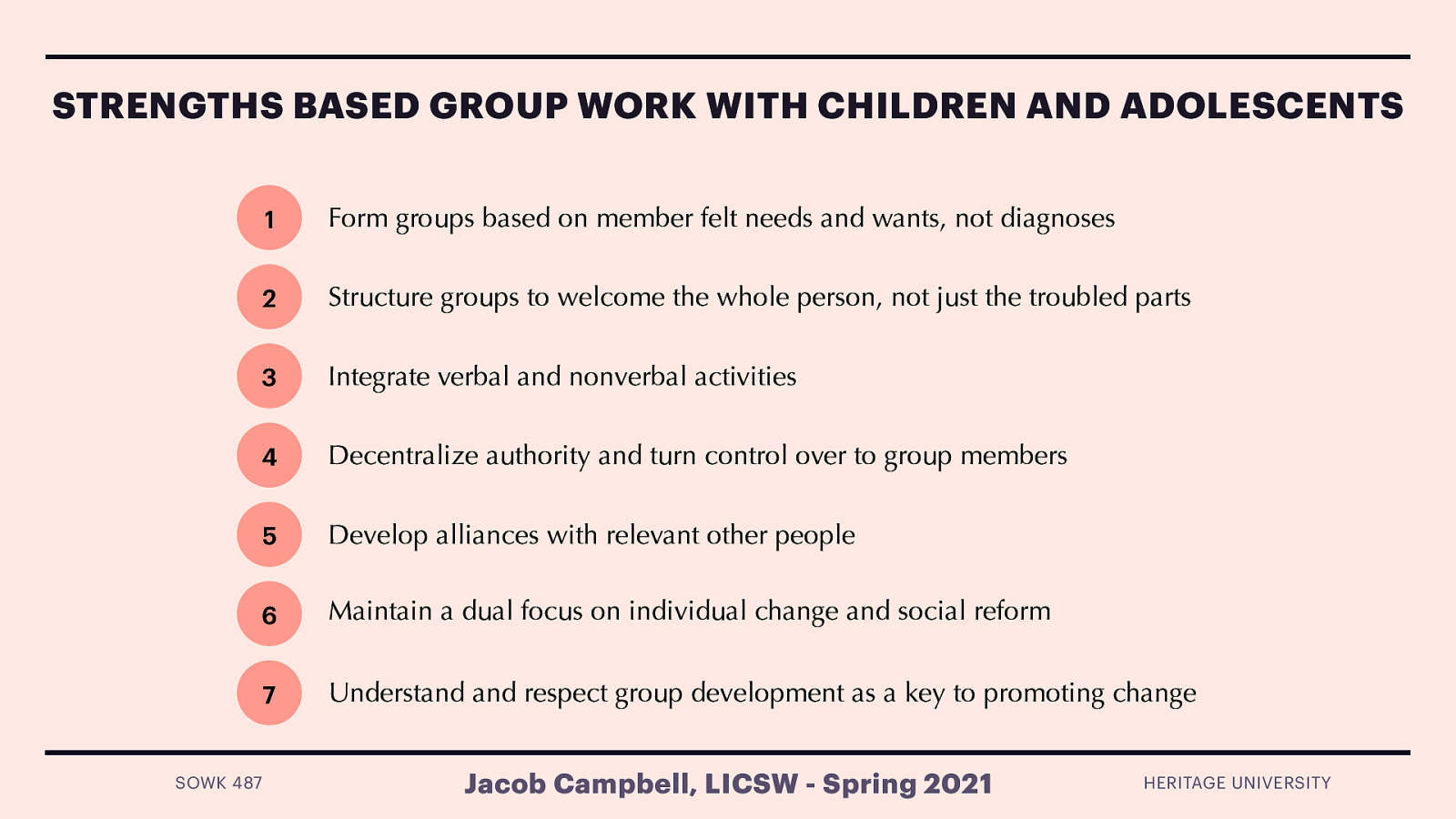
Strengths Based Group work with Children and Adolescents
- Principal 1: Form groups based on member felt needs and wants, not diagnoses
- Felt needs are individual wants, desires and areas of concerns both for the group and the individual
- Principal 2: Structure groups to welcome the whole person, not just the troubled parts
- Think ACES research and managing persons who have been through trauma
- Principal 3: Integrate verbal and nonverbal activities
- Allow creativity and movement
- Loved statement “Group work practitioners must, for once and for all, learn to relax and to abandon the strange and bizarre belief that the only successful group is one that consists of people who sit still and speak politely and insightfully” (p. 233)
- Principal 4: Decentralize authority and turn control over to group members
- Life space intervention (similar to LSCI)
- Principal 5: Develop alliances with relevant other people
- Connections with those outside of the group can be very productive.
- Principal 6: Maintain a dual focus on individual change and social reform
- Help self and help others
- Principal 7: Understand and respect group development as a key to promoting change
- Group processes
Week 11 moves into a three-part series of looking at groups that we complete focused on different populations. The first week has readings from Ruffolo and Maker (2017) where they dive into group work focused on mental health. As we know many of the groups that social workers end up facilitating include participants that are involuntary. Rooney and Chovanec (2017) offer many suggestions on how to be successful with this population. Finally, Malekoff (2017) talks about strength-based practices with youth, and Rittner (2017) looks specifically at child welfare. During class, we will be talking about bits and pieces of doing group work with each of these populations. We will also be doing a participatory activity out of Aggression Replacement Training.
Reference
Malekoff, A. (2017). Chapter 15 - Strengths-based group work with children and adolescents. In C. D. Garvin, L. M. Gutierrez, & M. J. Galinsky Handbook of Social Work with Groups (pp. 255-270). The Guilford Press.
Rittner, B. (2017). Chapter 16 - Group work in child welfare. In C. D. Garvin, L. M. Gutierrez, & M. J. Galinsky Handbook of Social Work with Groups (pp. 271-286). The Guilford Press.
Rooney, R., & Chovanec, M. (2017). Chapter 14 - Involuntary groups. In C. D. Garvin, L. M. Gutierrez, & M. J. Galinsky Handbook of Social Work with Groups (pp. 237-254). The Guilford Press.
Ruffolo, M. C., & Maker, C. M. (2017). Chapter 13 - Evidence-based group work in mental health practice. In C. D. Garvin, L. M. Gutierrez, & M. J. Galinsky Handbook of Social Work with Groups (pp. 220-236). The Guilford Press.
